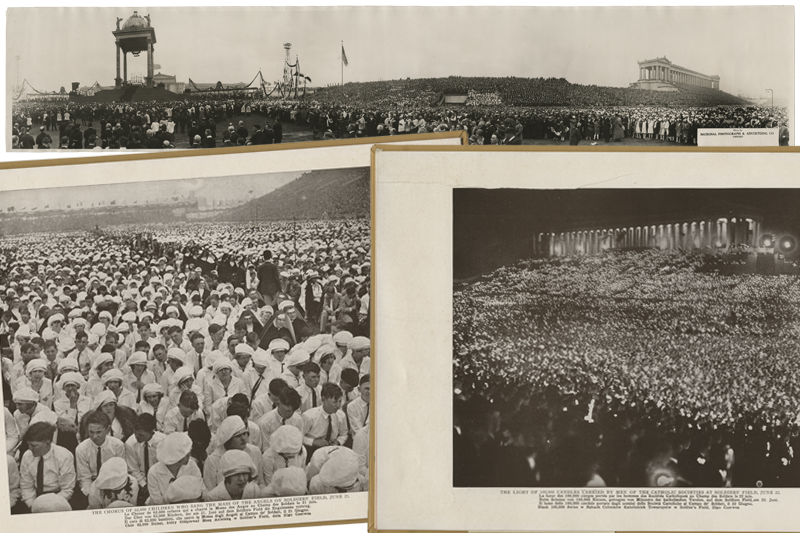Blogs

Eucharistic Congress 1926: A Watershed Moment for Chicago, Catholicism
By Stephanie Shreffler
In 1926, a crowd of hundreds of thousands descended on Chicago to partake in the 28th International Eucharistic Congress June 20-24. They attended Masses, lectures and discussions of the nature of the Eucharist throughout Chicago and the surrounding areas, demonstrating the increased acceptance of Catholics in the United States. The congress also marked the growing importance of Chicago, which, until 1908, the Church had considered a mission territory.
The first International Eucharistic Congress was held in Lille, France, in 1881 as a result of the advocacy of Marie-Marthe-Baptistine Tamisier, a French laywoman. Congresses continued to be held regularly over the next several decades. Most were held in Europe, although the 1893 congress took place in Jerusalem. The first congress in North America was held in Montreal in 1910.
Promise to the pope: ‘A million communions’
In 1924, Cardinal George Mundelein began advocating for the next Eucharistic congress to be held in Chicago. He told Pope Pius XI, “Holy Father, permit the celebration of the next Eucharistic Congress to take place in Chicago and I promise you a million communions as a spiritual bouquet to your august presence.”1 The pope agreed, and preparations began.
The planning commission selected Soldier Field — current home of the Chicago Bears — to host several of the largest Masses. Planners also worked with railroad and steamship companies to plan for the transportation of hundreds of thousands of pilgrims to and from Chicago. Religious sisters made over 4.5 million hosts for the Masses, and over 60,000 local schoolchildren began practicing to sing in the choir for the children’s Mass.
Grandeur, fanfare … and choirs of thousands
Delegations to the congress came from all over the world. The pope’s delegation, which included six cardinals and 60 bishops, sailed from France on June 6, arriving in New York City on June 16. From there, they took a train to Chicago, arriving the next day. Mexico sent more than 900 Catholics to Chicago, while other delegations came from France, Poland, Germany and Italy.
On June 20, the congress officially opened with a large procession that included hundreds of church officials; about 250,000 people attended. The Chicago Symphony Orchestra performed at the opening Mass, its sound helpfully amplified by loudspeakers, which were a fairly recent invention. The second day was Children’s Day, and a choir of 62,000 schoolchildren from Catholic schools across the city sang during the Mass. The third day was Women’s Day, and the Mass featured a choir of 6,000 nuns and 3,500 women members of local choirs. That evening, over 200,000 men attended a candlelit service. The fourth day was Higher Education Day, and a choir of 3,000 high school and college students sang at the Mass.
The final day of the congress was June 24. Mass on this day was held at St. Mary of the Lake Seminary in Mundelein, Illinois, about 44 miles from downtown Chicago. Transporting hundreds of thousands of people from Chicago to Mundelein was a massive undertaking. Trains ran all night long, and thousands of people drove in cars. It is reported that by 4 a.m. that day, when the seminary gates opened, 12,000 people were already there.2
The final Mass took place at 10 a.m. on the steps of the seminary’s chapel. Afterward, Cardinal Giovanni Bonzano carried the Eucharist in a 2-mile-long Eucharistic procession throughout the grounds of the seminary.
A turning point toward tolerance, cooperation
The Eucharistic congress was a milestone in the history not only of Chicago, but of Catholics in the United States. American Catholics had faced prejudice and discrimination since the beginning days of the country, with many doubting whether a faithful Catholic could also be a good American citizen. The success of the congress rested on the cooperation of the city government, local businesses, the media, and everyday people. By hosting the congress, Chicago demonstrated its growing tolerance of Catholics and its growth as a major city.
Images and artifacts from congress on exhibit
To view photos and artifacts from the 28th International Eucharistic Congress, visit the exhibit Journeys of Faith: Shrines, Souvenirs and Catholic Tourism. For more information, visit go.udayton.edu/journeysoffaith.
— Stephanie Shreffler is an associate professor in the University Libraries and the collections librarian and archivist for the U.S. Catholic Special Collection.
1 “Bouquet,” Time, May 31, 1926, retrieved September 1, 2021, http://content.time.com/time/subscriber/article/0,33009,729276,00.html
2 Angela Pasyk, “XXVII International Eucharistic Congress - When 800,000 People Prayed at Mundelein,” published June 25, 2019, https://usml.edu/xxviii-international-eucharistic-congress-when-800000-people-prayed-at-mundelein/.
Image shown: collage of items from the U.S. Catholic Special Collection
- Panoramic photo was published by the National Photograph & Advertising Co., Chicago, Illinois, 1926.
- W. G. MacFarlane, International Eucharistic Congress Pictorial Album, Chicago, June 20-24, 1926. Published by American Autochrome Co., Chicago, Illinois, [1926?]
